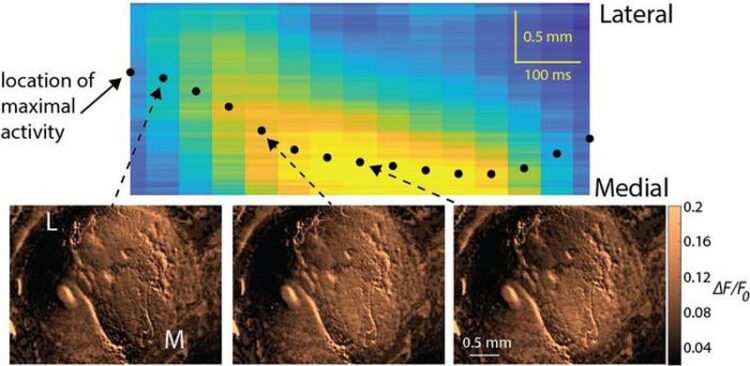A wave theory for a neurochemical balance in the brain

Acetylcholine wave traveling from lateral (L) to medial (M) in the striatum
Credit: Dr. Joshua Goldberg, Prof. Jeffery Wickens, Dr. Nicolas Tristch
In a new study, a group of researchers, led by Dr. Joshua Goldberg from the Hebrew University, describe a new kind of neurochemical wave in the brain. Their research, published in Nature Communications, unveils the existence of traveling waves of the neurochemical acetylcholine in the striatum, a region of the brain responsible for motivating actions and habitual behaviors.
The motivation to execute an action is widely thought to depend on the release of the another neurochemical, dopamine, in the striatum. Recent research has shown that dopamine is released in wave-like patterns within the striatum. The team led by Goldberg discovered that acetylcholine is also released in the striatum in wave-like patterns. It has long been thought that in order for the striatum to function properly a balance needs to be maintained between dopamine and acetylcholine release in the striatum, and that the disruption of this balance leads to movement disorders such as Parkinson’s disease. The new study proposes a mathematical mechanism by which simultaneous waves of acetylcholine and dopamine arise, which may represent how this balance is realized.
The research was conducted using state-of-the-art genetic tools and advanced imaging techniques, allowing the team to visualize the acetylcholine waves in awake, behaving animals. Additionally, imaging techniques were employed to observe the interaction between acetylcholine and dopamine in vitro. Through a rigorous mathematical analysis, using reaction-diffusion activator-inhibitor models and computer simulations, the team proposed a model that explains the formation of both acetylcholine (the activator) and dopamine (the inhibitor) traveling waves.
Key Highlights of the Study:
First description of acetylcholine waves: in the striatum of healthy behaving animals.
Local Dopamine Release is Triggered by individual non-dopamine neurons: The study demonstrated that electrical activation of a single acetylcholine-releasing neuron in the striatum is sufficient to induce local dopamine release in its proximity.
A novel model for how the two neurochemical waves arise simultaneously : The study proposes a novel mathematical model based on the known interaction between acetylcholine and dopamine in the striatum, that can give rise to the simultaneous generation of these waves.
Finally, the study provides strong testable predictions about the relationship between these two wave phenomena and the neural mechanism for their formation. The study also proposes that dopamine and acetylcholine axons (which are the very long appendages of the dopamine and acetylcholine neurons) interact directly and locally in the striatum, which is not how neurons are traditionally thought to interact.
Journal: Nature Communications
DOI: 10.5061/dryad.b5mkkwhk8
Method of Research: Experimental study
Subject of Research: Animals
Article Title: Acetylcholine waves and dopamine release in the striatum
Article Publication Date: 27-Oct-2023
Media Contact
Danae Marx
The Hebrew University of Jerusalem
danaemc@savion.huji.ac.il
Cell: 524334557
All latest news from the category: Life Sciences and Chemistry
Articles and reports from the Life Sciences and chemistry area deal with applied and basic research into modern biology, chemistry and human medicine.
Valuable information can be found on a range of life sciences fields including bacteriology, biochemistry, bionics, bioinformatics, biophysics, biotechnology, genetics, geobotany, human biology, marine biology, microbiology, molecular biology, cellular biology, zoology, bioinorganic chemistry, microchemistry and environmental chemistry.
Newest articles

Innovative 3D printed scaffolds offer new hope for bone healing
Researchers at the Institute for Bioengineering of Catalonia have developed novel 3D printed PLA-CaP scaffolds that promote blood vessel formation, ensuring better healing and regeneration of bone tissue. Bone is…

The surprising role of gut infection in Alzheimer’s disease
ASU- and Banner Alzheimer’s Institute-led study implicates link between a common virus and the disease, which travels from the gut to the brain and may be a target for antiviral…

Molecular gardening: New enzymes discovered for protein modification pruning
How deubiquitinases USP53 and USP54 cleave long polyubiquitin chains and how the former is linked to liver disease in children. Deubiquitinases (DUBs) are enzymes used by cells to trim protein…



